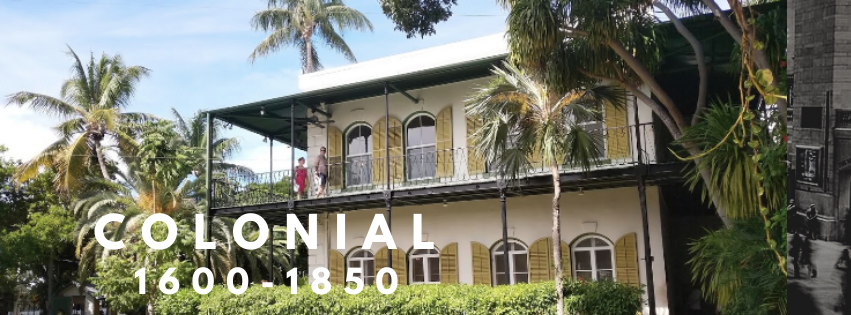Various house styles were developed during the Colonial period Colonial Georgian, Dutch Colonial, French Colonial and Spanish Colonial. French Colonial
The main subtypes of Colonial homes are French Colonial, Spanish Colonial, Dutch Colonial, German Colonial, Mid-Atlantic Colonial, and Colonial Georgian.
The main subtypes of Colonial homes are French Colonial, Spanish Colonial, Dutch Colonial, German Colonial, Mid-Atlantic Colonial, and Colonial Georgian.
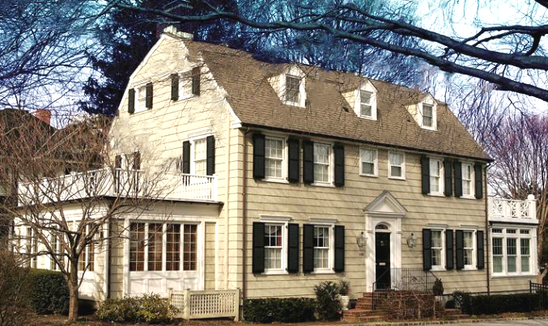
Dutch Colonial 1625 – 1850
Dutch Colonial homes were built by settlers who came from the Netherlands in the early- to mid-1600s. This is one of the most common types of house in America and is easily recognisable by its gambrel roof, narrow dormer windows and curved eaves, along the length of the house integrated into the roofline. This style continued into the 1850’s and then was revived later (see Dutch Colonial Revival style )
Where: New York State, areas in Delaware, Pennsylvania, New Jersey, and Western Connecticut,
Key features:
Dutch Colonial homes were built by settlers who came from the Netherlands in the early- to mid-1600s. This is one of the most common types of house in America and is easily recognisable by its gambrel roof, narrow dormer windows and curved eaves, along the length of the house integrated into the roofline. This style continued into the 1850’s and then was revived later (see Dutch Colonial Revival style )
Where: New York State, areas in Delaware, Pennsylvania, New Jersey, and Western Connecticut,
Key features:
- One story - occasionally one and half
- Matching chimneys on each side, or a massive wishbone-shaped chimney at the front
- Wide, slightly flared eaves
- Roof has little or no overhang
- Gambrel roof may have flared eaves
- Vertical board doors
- External treatment is wood clapboard, shingle, brick or stone
- Often symmetrical, but can have side entries and balanced asymmetry
- Gable-end chimneys
- Windows in gable end are heavily decorated
- Porch is set below overhanging eaves
- Porch sometimes runs the full width of the house
- Front entrance doorways may have a decorative hood with brackets
- Sometimes entrance door is porticoed with classical-styled columns
- Windows are multi-light such as six-over-one, six-over-six, or eight-over-eight
- Shed, hipped, or gable dormers
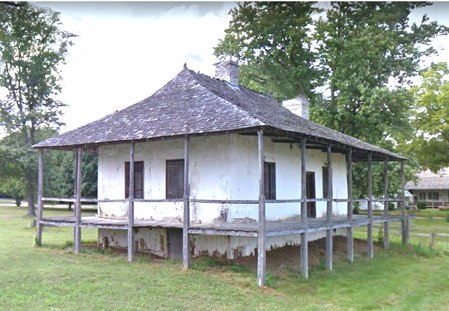
French Colonial 1700 -1830
These houses were first built by the settlers from France and Canada along the lower Mississippi River delta and can be distinguished by the steep hipped or side gabled roofs with wide overhangs
Where: South Coastal, Louisiana, Mississippi,Ohio river, St Louis and Louisville
Key features:
These houses were first built by the settlers from France and Canada along the lower Mississippi River delta and can be distinguished by the steep hipped or side gabled roofs with wide overhangs
Where: South Coastal, Louisiana, Mississippi,Ohio river, St Louis and Louisville
Key features:
- Mainly single storey
- External finishes half-timbered or brick, stucco and later weather boarding
- Symmetrical plan
- Roof high and steep, hipped or pyramid shaped
- Side gabled, sometimes hipped roofs in towns
- Exceptionally large overhanging eaves
- Extensive porches, sometimes wrap around the house
- Porches have wooden columns in rural examples
- Windows double, French style doors with shutters
- Windows on upper floor very tall
- Many doors on external walls
- Shutters opened outwards – windows opened inwards
- Porches have balustrades
- Doorways arched
- Exterior staircases were common in buildings that had two storeys .
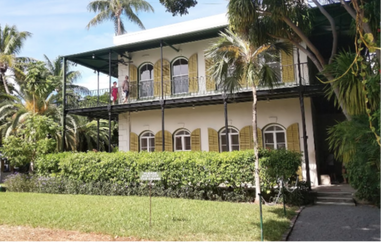
Spanish Colonial 1600 – 1850
Settlers from Spanish territories bought with them this classic design of simple low homes which had been the mainstay in Spain for over 400 years. The white stucco walls and red roof tiles quickly made them a very popular style. Homes built in this style began to be popular once again in the 20th century (see Spanish Revival)
Where: California, and the American South West
Key features:
· Inner courtyard.
Settlers from Spanish territories bought with them this classic design of simple low homes which had been the mainstay in Spain for over 400 years. The white stucco walls and red roof tiles quickly made them a very popular style. Homes built in this style began to be popular once again in the 20th century (see Spanish Revival)
Where: California, and the American South West
Key features:
- One storey
- Flat roof, or roof with a low pitch
- Earth, thatch, or clay tile roof covering
- Thick walls, stucco exterior
- Several exterior doors
- Small windows open - originally without glass
- Wooden or wrought iron bars across the windows
- Interior shutters
- Very little ornamentation
· Inner courtyard.
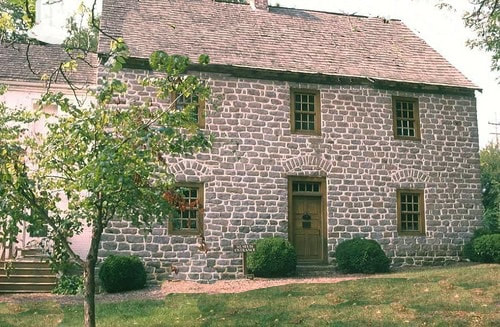
German Colonial (1680- 1850)
Homes built by German settlers were well known for their thick stone walls and exposed half-timber beams popular in Europe. A variation was the "bank house" which was built into the hillside to provide added protection form the extreme temperatures
Where: New York, Pennsylvania, Ohio, Delaware and Maryland
Key features:
Homes built by German settlers were well known for their thick stone walls and exposed half-timber beams popular in Europe. A variation was the "bank house" which was built into the hillside to provide added protection form the extreme temperatures
Where: New York, Pennsylvania, Ohio, Delaware and Maryland
Key features:
- Two-feet thick walls made with sandstone
- Reinforced stone arches above the first-floor windows and doors
- Hand-hewn beams pinned with wooden pegs
- Exposed half-timbering
- Flared eaves
- Massive wishbone-shaped chimney
- Roof gabled
- Roof tiled or wood shingles
- Sometimes an attic with windows in gable ends
- Shed dormers on the roof
- Entrance porch at side – sometimes at the front
- Windows – small casement with shutters or double sash replacements
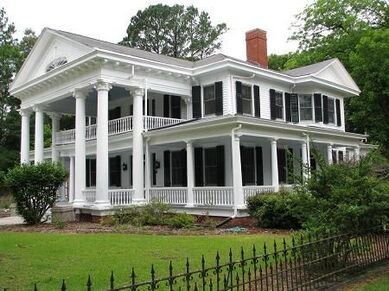
Early Classical Revival 1790 - 1830
Based upon Roman models these have full height entry porches with a triangular feature above (pediment) set against a simple side gabled or hipped roof. Designers, as the classical revival progressed, soon started looking at the classical Greek styles and incorporated them and so we have the Greek Classical Revival style.
Where: Virginia and the Southern States
Key features:
Based upon Roman models these have full height entry porches with a triangular feature above (pediment) set against a simple side gabled or hipped roof. Designers, as the classical revival progressed, soon started looking at the classical Greek styles and incorporated them and so we have the Greek Classical Revival style.
Where: Virginia and the Southern States
Key features:
- Most common materials were wood but brick stucco or stone could be used
- Entrance Porch (portico) centre
- Two storey but sometimes one
- Side gabled and hipped roofs
- Doric frieze
- Porch is full height and sometimes two tiered
- Porches are varied – some are recessed inwards
- Porch roof is supported by four (sometimes two) columns with pediment
- Low pitched roof with side gables
- Symmetrically aligned windows and door (5 bay front facade are most common)
- Large windows and doors
- Crescent shaped window in portico pediment
- Semi-circular fanlight over panelled front door
- Wide band of trim around facade not so wide in earlier homes
- Roof balustrades are not common
- Dormers unlikely
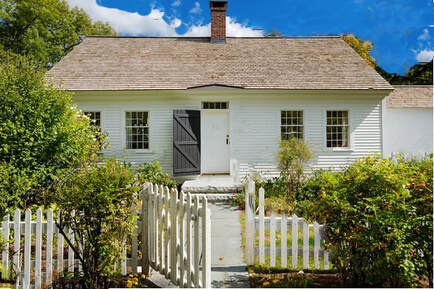
Cape Cod 1620- 1820
The Cape Cod has been described as the quintessential American house and they were built by settlers throughout New England into the mid-1800s. It is a low, broad, single-story frame building with a moderately steep pitched gabled roof, a large central chimney, and very little ornamentation. This style was revived in the 20th century
There are three basic shapes to the Cape Cod style house-
Double Cape This is the one everyone knows but it is actually not all that common. It has a steep pitched roof and a symmetrical five-bay façade with a central, slightly over large, entrance door centred.
Three-Quarter Cape- the most popular in the 18th- and early-19th-century. The entry was offset slightly.
Single Cape Started life as the simplest form and later additions were made to make it three quarter or full cape but some original styles exist.
Where: New Hampshire, Massachusetts Bay, Rhode Island and Connecticut.
Key features:
The Cape Cod has been described as the quintessential American house and they were built by settlers throughout New England into the mid-1800s. It is a low, broad, single-story frame building with a moderately steep pitched gabled roof, a large central chimney, and very little ornamentation. This style was revived in the 20th century
There are three basic shapes to the Cape Cod style house-
Double Cape This is the one everyone knows but it is actually not all that common. It has a steep pitched roof and a symmetrical five-bay façade with a central, slightly over large, entrance door centred.
Three-Quarter Cape- the most popular in the 18th- and early-19th-century. The entry was offset slightly.
Single Cape Started life as the simplest form and later additions were made to make it three quarter or full cape but some original styles exist.
Where: New Hampshire, Massachusetts Bay, Rhode Island and Connecticut.
Key features:
- Symmetrical appearance with central front door
- One or one and half storeys
- Constructed of wood and brick
- Simple style
- Shingle or clapboard exterior siding
- Post and beam, rectangular footprint
- One story with additional half story under roof
- Fairly steep roof with shallow overhang
- Side gables
- Gabled dormer either side of the chimney
- Clerestory windows
- Centre chimney linking each fireplace
- Little ornamentation on exterior
- Rarely has porches, embellishments, or decorations
- Windows either side of front door
- Double-hung windows with shutters
- Low ceilings
- Symmetrical layout inside with a central hall
- Large, open living space
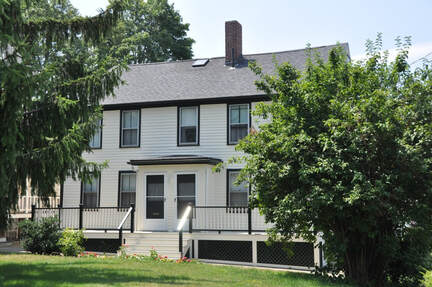
Georgian Colonial 1690- 1780
Early settlers and builders bought Georgian style architecture to their new country. The earliest homes were constructed of materials that were easy to utilise so timber clapboards and even columns made of timber were used.
Where: South and North Carolina, Virginia, Philadelphia, New Hampshire, Maine, New York
Key features:
Early settlers and builders bought Georgian style architecture to their new country. The earliest homes were constructed of materials that were easy to utilise so timber clapboards and even columns made of timber were used.
Where: South and North Carolina, Virginia, Philadelphia, New Hampshire, Maine, New York
Key features:
- Brick in the south sometimes stucco
- Clapboards or shingle in the north
- Square, symmetrical shape
- Medium pitched roof
- Roof mainly side- gabled
- Some rooves are gambrel, hipped or occasionally centred gable
- Dormers in roof
- Exterior sometimes decorated with wooden quoins
- Panelled front door at centre with pilasters
- Decorative crown over front door
- Flattened columns on each side of door
- Five windows across front
- Windows consist of small panes - 9 or 12 in each window sash
- Double hung sash windows
- Paired chimneys
- Minimal roof overhang
- Transom lights, and sometimes a pedimented crown
- A small block (dentil) moulding at the cornice
- Front door often has a decorative triangular gable
- Front door sometimes has ogee caps
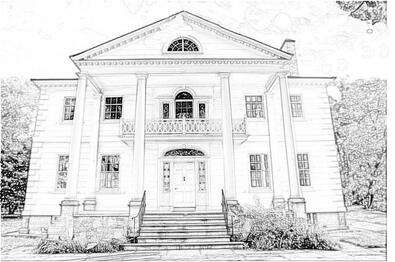
FEDERAL (Adamesque) 1780 -1820
The Federal, or Adam architectural style was very popular from 1780 to 1820, during the great population expansion on the seaports on the Eastern Seaboard. It is a style that has its origins very much in the preceding Georgian architecture which was a very simple box, usually two rooms deep with symmetrical doors and windows. The Federal style was slightly different because it could have projecting wings and overall is to a slightly smaller scale.
External decoration is generally confined to a porch or doorway. Compared to a Georgian house, the columns and mouldings are narrow and quite simple.
Where: in virtually every eastern city, from New England's seaport towns to Georgetown and Alexandria, Virginia.
Key features:
The Federal, or Adam architectural style was very popular from 1780 to 1820, during the great population expansion on the seaports on the Eastern Seaboard. It is a style that has its origins very much in the preceding Georgian architecture which was a very simple box, usually two rooms deep with symmetrical doors and windows. The Federal style was slightly different because it could have projecting wings and overall is to a slightly smaller scale.
External decoration is generally confined to a porch or doorway. Compared to a Georgian house, the columns and mouldings are narrow and quite simple.
Where: in virtually every eastern city, from New England's seaport towns to Georgetown and Alexandria, Virginia.
Key features:
- Simple square or rectangular box shaped
- Mainly two rooms deep
- Low-pitched roof, or flat roof with a balustrade
- Roof side gabled but could be hipped or centre gabled
- Windows arranged symmetrically around a centre doorway
- Semi-circular fanlight over the front door
- Narrow side windows flanking the front door
- Decorative crown or roof over front door
- Tooth-like dentil mouldings in the cornice
- Palladian (three part)window
- Circular or elliptical windows
- 6-over-6 double-hung sash windows
- Sashes are fixed upper and opening lower
- Shuttered windows
- Decorative swags and garlands
- Oval rooms and arches
- Fanlight and elliptical window in the gable
- Early buildings may have new windows at the front and old fashioned ones at the back
- Decorative swags and garlands
- Panelled door with elaborate surround.
- Staircases are often curved , classically finished and wide open
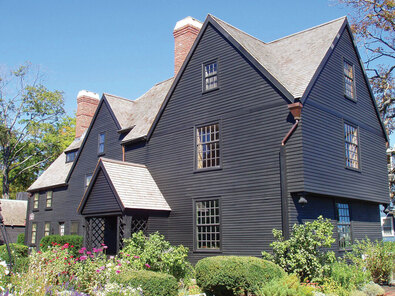
New England 1630-1740
The Colonial House of the Seven Gables (1668) in Salem, Massachusetts is a great example of this New England Architectural style. The British settled there and built rustic, square homes taking inspiration from Medieval Europe.
Where :New England
The Colonial House of the Seven Gables (1668) in Salem, Massachusetts is a great example of this New England Architectural style. The British settled there and built rustic, square homes taking inspiration from Medieval Europe.
Where :New England
- Massive chimney at the centre
- Second story protruding over first story
- Saltbox roof shape that slopes down in the rear
- Diamond-paned windows
